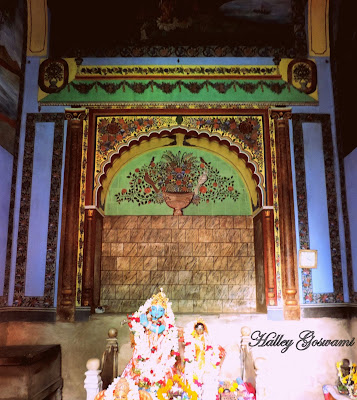Bhaandara loot and Rathayatra at Guptipara
 |
| Jagannath dev being placed in chariot |
A day before the Punaryatra or ‘ulto roth’ceremony of Jagannath dev , the village of Guptipara is abuzz with signs of activity . Men busy oiling themselves up for a fight . To wrestle with each other not caring for injury or bruises that may come in the way . Within the walls of Gundicha temple various cooked food items have been horded . Each recipe carefully cooked and filled in new earthern pots numbering more than 400 . Each pot capable of holding 5 kilograms of food . They have all been offered ritually to Lord Jagannath dev and now lie as prasad . Some contain warm ‘khhichree’ or ‘pulaao’. Ohers filled with ‘Maalpua’ , Fries of different kinds , fruits , ‘kheer’, ‘paayesh’ , sweets and what not ! Now the final moment arives . As soon as the temple is opened , hordes of people barge inside and try to forcefully take as much prasad as they can ! Sounds of blows can be heard from outside the walls too ! A total anarchy and fight for Jagannath prasad ! It has been said that there is no sin in stealing prasad . In fact it is considered good to be greedy for prasad . Concesrated food of Jagannath is the holiest of holy and is capable of purifying us inside out . Which is why there is no harm to fight over it ! This is how Rathayatra has been celebrated for 280 long years in BrindavanChandra mutt in Guptipara of Hooghly district !
 |
| Balabhadra being lifted |
The present mohant head of the mutt , swami Govindananda Puri says that the tradition originated with a puranic lore . Jagannath had a fight with his wife , Lakshmi and left home for peace at his aunt’s place in Gundicha temple . Lakshmi became suspicious of this hasty departure and became anxious of ‘parakiyaa’ or extra martial affair of her husband ! Then she comes to know from Vrinda devi that her lord is now residing as his aunt’s place . In order to turn his attention towards her , she goes to gundicha in secret and scatters black mustard seeds ( sorshe pora ) with incantations in the house . However the black magic failed to work any wonder . Then at the request of Lakshmi , Vrinda devi sends her people to investigate whats going on in the house . Upon arrival , the men sees all the doors shut from inside . They barge their way in and loots the food that was inside .
Records say that in 1858 , one lakh people arrived to witness this festival of ‘Bhaandaaraa loot’ !
Guptipara rose to prominence in 16th century as a place of learning and culture . Brahmins pundits and vaidyas made this place their home and eventually it developed into an important place for cultivation of nyaaya and smriti shastras . In the second half of 1500s , a certain Satyadev Saraswati , a monk belonging to dasanami order of Shankaracharya founded a mutt here . He is said to have brought the wooden deity of Brindavanchandra from a house in Shantipur and had it installed within a remote forest called Krishnabaati , on the fringes of Guptipara . Later the deity was transfferred to new place .
 |
| Sri Brindavanchandra jiu |
 |
| Old homes such as these bear testimony to a rich past |
 |
| Brindavanchandra mutt |
The present temple complex has been built over a period of 500 years starting from the time of Mughal emperor Akbar . The main temple of
Brindavanchandra stands on a 5 feet high plinth . To the west of
Brindavanchandra temple is another temple dedicated to Radha Krishna , called
Krishnachandra temple . To the east lies Ramchandra temple . A dilapidated Jor
bangla styled temple dedicated to Gour nitai deities has now been renovated .
It had been lying abondoned for many yeas in past .
It is probably the oldest temple of Guptipara dating back to times of Akbar . The bulk of terracotta carvings of this temple was severely
eroded with age but provided a wonderful
evidence of terracotta works of early period . But sadly , they have now been entirely covered
in a plaster of cement and brick dust . Yet another case of restoration blunder
!
 |
| Jor baangla temple dedicated to Gour nitai is built in 1500s now stands renovated , although at the cost of its terracotta carvings |
KrishnaChandra temple is built is classic ‘aat chaalaa ‘style
in 1785 by the ninth mohanta of the mutt, in times of Alivardi Khan . Ramchandra temple is in ‘ek ratna’style and
is covered with intricate terracotta carvings
on its front and southern walls .
This temple was built towards the end of 18th century by the
rajah of Sheoraphuli – Harishchandra Raay .
The Brindachandra temle was built in 1810 by NayanChand Mullick . This temple is of prime importance because it is one of those very few temples in bengal to have been decorated with murals paintings of various gods and goddesses on its interior walls . The paintings show influence of both classical mughal and later british styles . But they have been retouched by modern painters which has distorted the original stylisation of the works to a considerable extent . But an expert eye would still be able to find out the old from the new .


























No comments:
Post a Comment